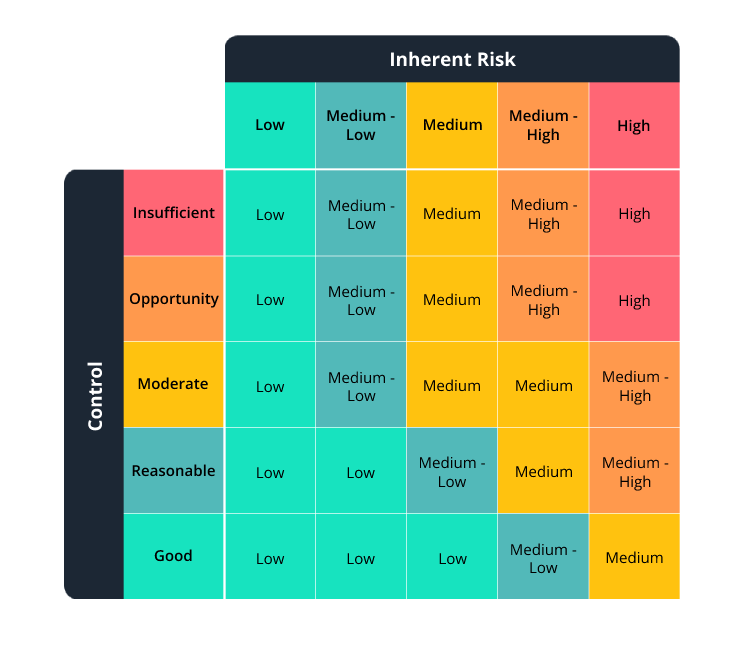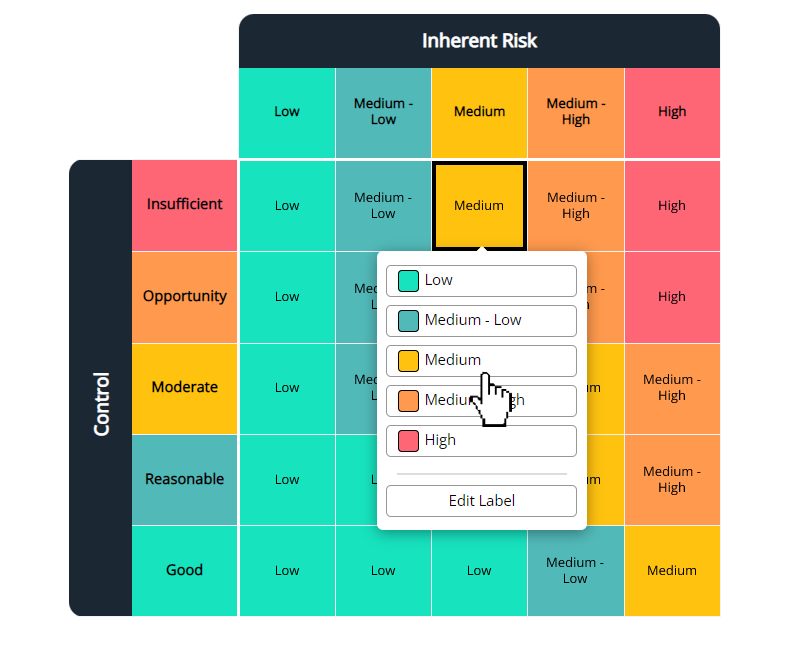Blog
Risk Matrix
Risk Matrix Mastery: Optimising Your Risk Assessments
What is a Risk Matrix?
A risk matrix is a visual tool used to assess and prioritise risks based on their likelihood and potential impact. It helps organisations identify and evaluate inherent risks, which are risks that exist without any controls in place. By considering controls, or measures put in place to mitigate risks, the matrix can also help calculate residual risks, which are the risks that remain after controls have been applied. Understanding the principles of the risk matrix can be a valuable step in the risk assessment process.
In a risk matrix, colours are used to visually represent the levels of risk. A low overall risk level is typically represented by the colour green, while medium risks are shown in yellow or orange, and high risks are depicted in red. This system allows stakeholders to quickly identify risks without referring to scores or numbers.
Commonly refered to as a ‘risk assessment matrix’, or ‘risk grid mapping’, these terms refer to the same tool as a simple risk matrix. This is a tool used in the process of a risk assessment that evaluates the likelihood and consequences of risks. Therefore, a risk matrix is sometimes called a risk assessment matrix.
Risk Matrix Methodology
The risk matrix is a methodology used to assess and manage risk by scoring inherent risks and controls effectiveness to calculate a residual risk score. The inherent risk score represents the potential risk of an activity or situation without any controls in place, while the controls effectiveness score represents the degree to which existing controls reduce the likelihood or impact of a risk. These two scores are combined in a matrix, which assigns a calculated residual risk score to each risk. The residual risk score is a measure of the remaining risk after controls have been implemented. This method measures risks, allocates resources to critical areas, and monitors control effectiveness over time.
INTRINSIC.
Inherent Risks
Risks that exist without any controls in place, and are inherent to the activity or process being assessed.
MITIGATION.
Controls
Measures put in place to mitigate risks, and reduce the likelihood or potential impact of a risk occurring.
ACCEPTED.
Residual Risks
The risks that remains after controls have been applied, and represents the actual level of risk in an organisation.
Inherent risk can be broken down into different levels, including low, medium-low, medium, medium-high, and high. Each level represents a different degree of potential risk, from minimal likelihood and insignificant impact to very high likelihood and severe impact.
Controls effectiveness can also be broken down into different levels, including good, reasonable, moderate, opportunity, and insufficient. These levels represent the degree to which existing controls are able to manage the identified risks, from well-designed and effective controls to non-existent or ineffective controls.
Once the inherent risk and controls effectiveness scores have been determined, they are combined to calculate a residual risk score. This score provides a measure of the remaining risk after controls have been implemented and can be used to prioritise risk management activities. The higher the residual risk score, the greater the need for additional controls or risk mitigation efforts. Overall, the risk matrix provides a structured and systematic approach to identifying, assessing, and managing risks, and can help organisations to make informed decisions about where to allocate resources and focus risk management efforts.
Risk Matrix Example
The risk matrix can be customised to suit the specific needs and risk preferences of an organisation.
For instance, some organisations may be more risk averse than others and may want to take a more cautious approach to risk management. In this case, they may choose to adjust the matrix so that the risk thresholds are set at lower levels, with a greater emphasis on controls and risk mitigation efforts.
On the other hand, a more risk-tolerant organisation may prefer to set the risk thresholds at higher levels, with a greater focus on identifying and accepting risks that are within their risk appetite. In this way, a risk mapping can be tailored to meet the unique needs of different organisations and help them to manage their risks in a way that aligns with their overall risk management strategy.
While the risk matrix is a relatively simple tool, its flexibility allows it to be used in a variety of ways and adapted to suit different contexts and risk profiles. View a variety of different fun and creative Risk Matrix Themes for you to use.

Benefits of a Risk Matrix
A risk matrix is an essential tool that provides numerous benefits for project planning and management. Some of the advantages of using it include:
- Clear Visualisation: The colour-coding system provides a clear visualisation of the level of risk. This makes it easier for project managers to understand the potential risks involved and to take necessary actions.
- Prioritisation: A risk mapping enables project managers to prioritise risks based on their level of severity. This allows them to focus their attention on the most critical risks and allocate resources accordingly.
- Risk Reduction: By identifying and analysing potential risks, this can help project managers to develop strategies for reducing or eliminating those risks. This can minimise the impact of potential risks and increase the likelihood of project success.
- Decision-Making: It provides valuable insights that help project managers to make informed decisions. By evaluating the likelihood and impact of potential risks, project managers can choose the best course of action for their project.
- Communication: A risk matrix is an effective communication tool that enables project managers to share information about potential risks with stakeholders. This helps to ensure that everyone is aware of the risks involved and can take necessary precautions.
Creating your own Risk Matrix in RISKGRID
Creating a risk matrix in RISKGRID is a simple process that allows you to define your own custom risk mapping. To get started, first, define your own labels that align with your organisation's risk preferences. Next, select pre-existing risks or create your own inherent risks and controls. You can use the built-in risk library or add your own custom risks and controls.
You can tailor your risk mapping by customising the size of your matrix, allowing you to define more granular risk. With RISKGRID, you can expand your grid matrix up to a 9x9 size, giving you the flexibility to assess risks in greater detail and capture more nuances. This customisation option ensures that your matrix is not only easy to use and understand but also tailored to your organisation's specific needs.
Once you have defined your risks and controls, you can fill out your mapping shown in the picture below depending on your risk appetite.
With RISKGRID, you can quickly and easily create a custom risk matrix that reflects your organisation's unique risk profile. The intuitive interface, coupled with the ability to define your own custom labels and risks, makes it easy for anyone to create a comprehensive risk mapping. Plus, once you have created your mapping, you can continually update and refine it as your organisation's risk profile evolves.
With RISKGRID, you have the flexibility to set up different projects with unique risk matrices, customised risk categories, controls, and ratings to fit each project's nature. Alternatively, you can share the same risk matrix across multiple projects, streamlining your risk assessment and management processes for efficiency.

Utilising the Results of Your Risk Matrix
Utilising the results of your risk matrix is a critical step in managing project risks. The risk matrix helps to identify and prioritise risks, as well as plan for and mitigate potential risks.
One important step is to communicate the results of the risk matrix to all stakeholders. This ensures that everyone involved in the project is aware of the risks and can take appropriate actions to mitigate them. It's also important to continually monitor and update the risk mapping as the project progresses and new risks emerge.
Another key action is to develop strategies for mitigating the identified risks. This may involve developing remediation plans, allocating additional resources, or implementing risk management techniques such as risk transfer or risk avoidance.
It's also important to regularly review and assess the effectiveness of the risk mitigation strategies. This ensures that the project remains on track and that any changes in the risk profile are identified and addressed in a timely manner.
Optimising Your Risk Assessments Summary
In conclusion, a risk matrix is a valuable tool that can help organisations identify and prioritise potential risks, create action plans to address them, and ultimately reduce the likelihood and impact of negative outcomes. By using RISKGRID's user-friendly platform, creating and customising your own risk mapping has never been easier. With the ability to select from pre-existing risks or define your own, as well as customise the labels and size of the matrix, RISKGRID empowers you to tailor your risk management approach to your specific needs and risk appetite.
The ability to collaborate and share your risk matrix with your team also ensures that everyone is on the same page and working towards the same goals. By utilising the results of your risk matrix and taking proactive measures to mitigate potential risks, you can increase the likelihood of project success and protect your organisation's assets and reputation. So why not give RISKGRID a try and see how it can help you take your risk management to the next level?
Enhance your risk matrix
We believe that leveraging the power of the risk matrix through digital tools is the key to unlocking a more streamlined and effective risk management process, with far-reaching benefits for your organisation.
- Efficient Workflow: Easily map out the relationship between inherent risk, controls, and residual risk, all in one intuitive workflow.
- Customisation: Tailor your risk matrix to your specific needs, with customisable grid size, descriptions, and colour coding options.
- Flexible Risk Mapping: Choose from a variety of pre-defined risk mapping options, or create your own bespoke labels to suit your unique risk assessment requirements.
- Editable and Redefinable: RISKGRID's redefinable risk mapping allows you to edit and update your assessment at any time, providing a flexible and adaptable solution.
- Mulitple Risk Matrices: Use a different mapping for each project or share the matrix between projects depending on your risk appetite.
- Improved Decision-Making: Use the custom criteria you define to evaluate risks and make informed decisions that support your business objectives.
